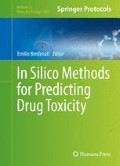Abstract
Modeling developmental toxicity has been a challenge for (Q)SAR model developers due to the complexity of the endpoint. Recently, some new in silico methods have been developed introducing the possibility to evaluate the integration of existing methods by taking advantage of various modeling perspectives. It is important that the model user is aware of the underlying basis of the different models in general, as well as the considerations and assumptions relative to the specific predictions that are obtained from these different models for the same chemical. The evaluation on the predictions needs to be done on a case-by-case basis, checking the analogs (possibly using structural, physicochemical, and toxicological information); for this purpose, the assessment of the applicability domain of the models provides further confidence in the model prediction. In this chapter, we present some examples illustrating an approach to combine human-based rules and statistical methods to support the prediction of developmental toxicity; we also discuss assumptions and uncertainties of the methodology.
Access this chapter
Tax calculation will be finalised at checkout
Purchases are for personal use only
References
Hood R (2011) Developmental and reproductive toxicology: a practical approach, 3rd edn. CRC, Boca Raton, FL
Regulation (EC) No. 1907/2006 of the European Parliament and of the Council, of December 18, 2006 concerning the Registration, Evaluation, Authorization and Restriction of Chemicals (REACH), establishing a European Chemicals Agency, amending Directive 1999/45/EC and repealing Council Regulation (EEC) No 793/93 and Commission
OECD guidelines for the testing of chemicals, section 4. OECD Publishing, Paris
OECD (2001) Test No. 414: prenatal development toxicity study, OECD guidelines for the testing of chemicals, section 4. OECD Publishing, Paris
OECD (2001) Test No. 416: two-generation reproduction toxicity, section 4. OECD Publishing, Paris
OECD (1995) Test No. 421: reproduction/developmental toxicity screening test, OECD guidelines for the testing of chemicals, section 4. OECD Publishing, Paris
OECD (1996) Test No. 422: combined repeated dose toxicity study with the reproduction/developmental toxicity screening test, OECD guidelines for the testing of chemicals, section 4. OECD Publishing, Paris
OECD (2007) Test No. 426: developmental neurotoxicity study, OECD guidelines for the testing of chemicals, section 4. OECD Publishing, Paris
OECD (2012) Test No. 443: extended one-generation reproductive toxicity study, OECD guidelines for the testing of chemicals, section 4. OECD Publishing, Paris
Virtual models for evaluating the properties of chemicals within a global architecture. http://www.vega-qsar.eu/
Cassano A, Manganaro A, Martin T, Young D, Piclin N, Pintore M, Bigoni D, Benfenati E (2010) CAESAR models for developmental toxicity. Chem Central J 4(Suppl 1):S4
Arena VC, Sussman NB, Mazumdar S, Yu S, Macina OT (2004) The utility of structure-activity relationship (SAR) models for prediction and covariate selection in developmental toxicity: comparative analysis of logistic regression and decision tree models. SAR QSAR Environ Res 15:1–18
Wu S, Fisher J, Naciff JM, Laufersweiler MC, Lester C, Daston G, Blackburn K (2013) A framework for identifying chemicals with structural features associated with potential to act as developmental or reproductive toxicants. Chem Res Toxicol 26:1840–1861
Laufersweiler M, Gadagbui B, Baskerville-Abraham I, Maier A, Willis A, Scialli A, Carr G, Felter S, Blackburn K, Daston G (2012) Correlation of chemical structure with reproductive and developmental toxicity as it relates to the use of the threshold of toxicological concern. Regul Toxicol Pharmacol 62:160–182
Kroes R, Renwick A, Cheeseman M, Kleiner J, Mangelsdorf I, Piersma A, Schilter B, Schlatter J, van Schothorst F, Vos J, Wurtzen G (2004) Structure-based thresholds of toxicological concern (TTC): guidance for application to substances present at low levels in the diet. Food Chem Toxicol 42:65–83
Maślankiewicz L, Hulzebos E, Vermeire T, Muller J, Piersma A (2005) Can chemical structure predict reproductive toxicity? RIVM report 601200005/2005
Schardein JL (2000) Chemically induced birth defects. Marcel Dekker Inc., New York
Matthews EJ, Kruhlak NL, Benz RD, Contrera JF (2007) A comprehensive model for reproductive and developmental toxicity hazard identification: I. Development of a weight of evidence QSAR database. Regul Toxicol Pharmacol 47:115–135
Matthews EJ, Kruhlak NL, Benz RD, Ivanov J, Klopman G, Contrera JF (2007) A comprehensive model for reproductive and developmental toxicity hazard identification: II. Construction of QSAR models to predict activities of untested chemicals. Regul Toxicol Pharmacol 47:136–155
Chakravarti SK, Saiakhov RD, Klopman G (2012) Optimizing predictive performance of CASE Ultra expert system models using the applicability domains of individual toxicity alerts. J Chem Inf Model 52:2609–2618
Klopman G (1992) MULTICASE 1. A hierarchical computer automated structure evaluation program. Quant Struct Act Relat 11:176–184
Yang C, Cross K, Myatt GJ, Blower PE, Rathman JF (2004) Building predictive models for protein tyrosine phosphatase 1B inhibitors based on discriminating structural features by reassembling medicinal chemistry building blocks. J Med Chem 47:5984–5994
Floris M, Manganaro A, Nicolotti O, Medda R, Mangiatordi GF, Benfenati E (2014) A generalizable definition of chemical similarity for read-across. J Cheminform 6:39
Quantitative Structure Activity Relationship, Toxicity Estimation Software Tool (TEST). http://www.epa.gov/nrmrl/std/qsar/qsar.html. Accessed 19 Jun 2015
The OECD QSAR Toolbox. http://www.oecd.org/chemicalsafety/risk-assessment/theoecdqsartoolbox.htm
Author information
Authors and Affiliations
Corresponding author
Editor information
Editors and Affiliations
Rights and permissions
Copyright information
© 2016 Springer Science+Business Media New York
About this protocol
Cite this protocol
Marzo, M., Roncaglioni, A., Kulkarni, S., Barton-Maclaren, T.S., Benfenati, E. (2016). In Silico Model for Developmental Toxicity: How to Use QSAR Models and Interpret Their Results. In: Benfenati, E. (eds) In Silico Methods for Predicting Drug Toxicity. Methods in Molecular Biology, vol 1425. Humana Press, New York, NY. https://doi.org/10.1007/978-1-4939-3609-0_8
Download citation
DOI: https://doi.org/10.1007/978-1-4939-3609-0_8
Published:
Publisher Name: Humana Press, New York, NY
Print ISBN: 978-1-4939-3607-6
Online ISBN: 978-1-4939-3609-0
eBook Packages: Springer Protocols

